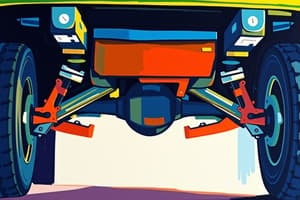Podcast
Questions and Answers
What is the primary function of joints in the human body?
What is the primary function of joints in the human body?
- They store minerals and nutrients.
- They protect internal organs.
- They enable movement between bones.
- They hold the bones together securely. (correct)
Which of the following is NOT a function of joints?
Which of the following is NOT a function of joints?
- They produce red blood cells. (correct)
- They connect various bones.
- They absorb shock during movement.
- They allow flexibility in movement.
What is a joint?
What is a joint?
- A fluid-filled sac providing joint lubrication
- A type of tissue that connects muscles
- A structure that supports bodily weight
- A meeting of two or more bones (correct)
In the context of the skeletal system, the term 'patella' refers to which of the following?
In the context of the skeletal system, the term 'patella' refers to which of the following?
Which of the following factors affects the range of movement in joints?
Which of the following factors affects the range of movement in joints?
What are the two main functions of joints?
What are the two main functions of joints?
What does Hilton's law state?
What does Hilton's law state?
Which statement best describes the role of joints in the body?
Which statement best describes the role of joints in the body?
Applied anatomy is primarily concerned with which of the following?
Applied anatomy is primarily concerned with which of the following?
Which of the following does NOT impact the range of movement at a joint?
Which of the following does NOT impact the range of movement at a joint?
What type of joint is represented by the connection between the lower ends of the tibia and fibula?
What type of joint is represented by the connection between the lower ends of the tibia and fibula?
Which statement is true regarding the inferior tibiofibular joint?
Which statement is true regarding the inferior tibiofibular joint?
What structure connects the lower ends of the tibia and fibula in a syndesmosis?
What structure connects the lower ends of the tibia and fibula in a syndesmosis?
Which joint type involves the roots of teeth in their respective sockets?
Which joint type involves the roots of teeth in their respective sockets?
Which joint does NOT allow any movement?
Which joint does NOT allow any movement?
What condition may result from the degeneration of articular cartilage?
What condition may result from the degeneration of articular cartilage?
What typically happens to a joint when the articular cartilage deteriorates?
What typically happens to a joint when the articular cartilage deteriorates?
What is the result of complete ossification in the joint due to cartilage degeneration?
What is the result of complete ossification in the joint due to cartilage degeneration?
Which of the following is an incorrect statement regarding articular cartilage degeneration?
Which of the following is an incorrect statement regarding articular cartilage degeneration?
Which term describes the condition where bones in a joint become solidly fused and immobile?
Which term describes the condition where bones in a joint become solidly fused and immobile?
What is the primary role of the thin film of lubricant fluid found in the joint cavity?
What is the primary role of the thin film of lubricant fluid found in the joint cavity?
Which component forms the outer boundary of a synovial joint?
Which component forms the outer boundary of a synovial joint?
What are the types of ligaments associated with synovial joints?
What are the types of ligaments associated with synovial joints?
Which membrane is responsible for secreting synovial fluid in a joint?
Which membrane is responsible for secreting synovial fluid in a joint?
What is the primary function of the fibrous capsule surrounding a joint?
What is the primary function of the fibrous capsule surrounding a joint?
Flashcards are hidden until you start studying
Study Notes
Joint Characteristics
- A joint is the connection point between two or more bones, allowing for movement and stability.
- Primary functions of joints include:
- Holding bones together securely.
- Allowing for varying degrees of movement depending on the joint type.
Types of Joints
-
Syndesmoses:
- Example: Inferior tibiofibular joint, permits no movement.
- Bones are connected by fibrous tissue, specifically the interosseous ligament.
-
Gomphosis:
- Refers to the attachment of teeth within their alveoli (sockets).
Joint Structure
- Joints contain several important components:
- Synovial cavity filled with a thin layer of lubricant fluid.
- A fibrous capsule encasing the joint.
- Synovial membrane lining the joint cavity.
- Various ligaments: capsular, extracapsular, and intra-capsular, which provide stability.
Changes in Joint Condition
- Degeneration of articular cartilage can lead to ossification of the joint.
- This process may result in ankylosis, a condition where bones fuse together, causing immobilization.
Hilton’s Law
- States that the nerves supplying a joint also innervate the muscles that move the joint and the skin overlying the joint.
Applied Anatomy
- Understanding the structural and functional aspects of joints can aid in diagnosing and treating musculoskeletal issues.
Studying That Suits You
Use AI to generate personalized quizzes and flashcards to suit your learning preferences.




